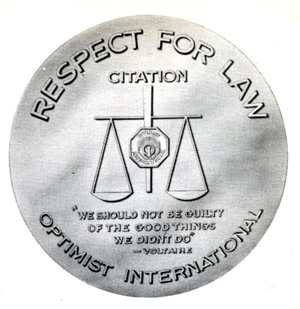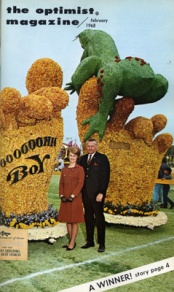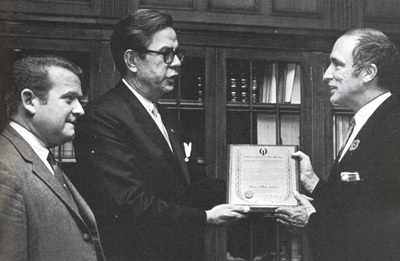| The August 1962 issue of The Optimist magazine brought news that the author of The Optimist Creed had died two months earlier. Christian D. Larson passed away in California at the age of 88. Besides being the man whom every Optimist has heard of and listened to through the words of the Creed, he reached many others through his writing, editing, publishing and lecturing. On February 26, 1962, after weeks of preparation, the staff of Optimist International moved into its first permanent home at 4494 Lindell Blvd. in St. Louis, Missouri, after being housed in rented offices for nearly 40 years. The Board of Directors held its first meeting in the new headquarters the following month. Everyone involved felt that the new building, constructed at a cost of $350,000, would provide ample space for the next 25 to 30 years. But just seven years later, at the International Convention, delegates voted to reactivate the building fund and assess each member 50 cents a year for the purpose of securing additional office space sometime in the future to accommodate the ever-growing organization’s needs. The era of numbers ended in Optimist International on July 1, 1964, as the 39 Optimist Districts got more than a number to identify themselves. The International Board of Directors approved a list of District names to replace District numbers, which had been used exclusively since 1919. In that first year, Optimist International divided into subdivisions, known as electoral sections. Each section encompassed a vast territory, in which the section leader (governor) was to travel and administer. As there were no Clubs in some of the areas, the prime responsibility of the section leader was to build new Clubs. |
 |
One of the most popular television shows in 1964 was the “Lawrence Welk Show,” featuring the popular bandleader and a host of singers. One of them, a man known as Alladin, had been in contact with the Optimists of the Wilshire, California, Club who introduced him to The Optimist Creed. So inspired by the tenets, the singer read the Creed to a national audience during one of the live Welk broadcasts that year. Another new community service program was launched in the summer of 1965, called “Respect for Law.” This program was launched with the proposal that Optimist Clubs, working in their community, attempt to combat the attitude of non-involvement, apathy and indifference toward crime, law enforcement and the dispensation of justice. As the years went by, Respect for Law became one of the organization’s most popular and long-lasting programs. |
| The International Convention in New Orleans in 1965 not only was the largest in the organization’s history up to that point—with 2,514 in attendance—but delegates also made several significant changes to the International Constitution and Bylaws. The structure of the Board of Directors was changed by creating a new position of President-Elect, and instead of four Vice Presidents and four Directors, there would be eight Vice Presidents. Delegates also gave the International Secretary-Treasurer the additional title of Executive Secretary. |
On a Wednesday afternoon in July of 1966, the longtime Executive Secretary of Optimist International, 54-year-old Bernard B. Burford, died of a heart attack while in his office visiting with 1966-67 President Robert Leonard. Immediately he appointed a special committee of Past Presidents to recommend to the Board a successor to Burford. By January of 1967, the Board, acting on the recommendation of the committee, reached into the ranks of its fellow volunteers to choose Hugh H. Cranford of Charlotte, North Carolina, as the new Executive Secretary. Cranford had 19 years of service to the organization at the Club, District and International levels. At 46, he had behind him a record of outstanding leadership as president of the Optimist Club of Charlotte, Governor of District 18 (North and South Carolina), a member of the Optimist International Board of Directors and seven years of service as chair of three International committees. In the 1960s, as racial barriers were crumbling across the United States, many Optimists began asking their organization to lift an unwritten policy banning African Americans from joining Optimist Clubs. In 1966, the Board of Directors, chaired by Robert H. Leonard of Knoxville, Tennessee, acted to remove the ban and open Optimist membership so that it reflected the wording in the Optimist International Constitution, which called for membership to “…represent a cross section of the business, social and cultural life of the community.” As part of the 50th anniversary celebration of the organization, a float appeared in the 1968 New Year’s Day Tournament of Roses parade. It consisted of a single figure, that of a typical kid, floating on his back in the “ol’ swimmin’ hole.” Perched on one bare big toe was a frog. And scrolled across the sole of one bare foot rising above the water were the words, “OOOOOOHH BOY!” The Optimist float garnered the Judges’ Special Award for Humor. |
 “OOOOOOHH BOY!” The Optimist float in the 1968 Tournament of Roses receives the judges' Special Award for Humor. |
| The year 1968-69 saw the advent of Operation Reach Out, a cooperative effort coordinated by the U.S. Office of Economic Opportunity, as well as Partners in Service, a joint program with the Boy Scouts of America. Project RSVP, which stood for Register, Study, Vote and Participate, was designed to renew and stimulate public interest, faith and participation in the government; to indicate that the problems in government at the time were not in the basic system but in the lack of active citizen interest and involvement in the process of making the elective system work. |
|
The following year, 1969, Optimists revitalized the Drug Abuse Information Program, developed in cooperation with the American Medical Association, which outlined steps to be taken by Optimist Clubs in working with local doctors, druggists and law enforcement officials in attacking the drug abuse problem. As the decade grew to a close and the organization celebrated its 50th year, membership passed the 100,000 mark and anticipation grew for the 3,000th Optimist Club to be built. The first half century of existence had seen the organization reach those lofty numbers from a start in 1919 with 11 Clubs and a total of 1,300 members. |
